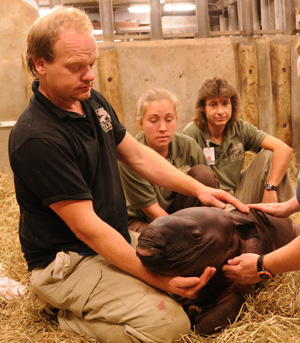Cincinnati Zoo Indian Rhino Gives Birth
CINCINNATI – Tuesday, October 26 – Nikki, the Cincinnati Zoo’s endangered Indian rhino gave birth early this morning to the world’s first live Indian rhino calf produced by artificial insemination (AI). Nikki delivered a male calf at 6:06 a.m. in her indoor stall. Currently, the calf is in critical condition with Zoo staff working diligently to feed and stabilize him. Meanwhile, Nikki is doing well and will remain indoors.
Nikki has been monitored 24 hours a day since the first of October. Nikki became increasingly restless throughout Monday evening into the night. Cincinnati Zoo Volunteer Observers called Zoo staff in early Tuesday morning. Nikki delivered her calf while volunteer and staff watched anxiously via a live video feed. As soon as the calf was born, but not moving or breathing, Zoo staff immediately jumped into action to assist and resuscitate the calf. The calf has been successfully breathing on its own since.
“The staff here at the Zoo is working tirelessly to do everything possible to support this calf,” said Dr. Monica Stoops, CREW Reproductive Physiologist and project leader at the Cincinnati Zoo & Botanical Garden. “We will continue to work to assist him during this critical period.”
Not only is this the world’s first successful live birth of an endangered Indian rhino conceived by artificial insemination (AI), but it is also the world’s first Indian rhino produced with frozen-thawed sperm.
Scientists at the Cincinnati Zoo’s CREW collected sperm in 2005 from a male Indian rhino at the Bronx Zoo and stored it at -320°F in CREW’s CryoBioBank for four years before it was thawed and utilized in the successful artificial insemination (AI) procedure in June 2009.
Three years ago, Nikki was the first endangered rhino to become pregnant through artificial insemination of frozen-thawed sperm. Unfortunately, after completing a full term pregnancy, Nikki delivered a stillborn calf. Approximately 50% of Indian rhinos that become first time mothers over the age of 10, like Nikki had been, experience a stillbirth. Despite the devastating outcome, Zoo staff looked to the future and were comforted by the fact that female Indian rhinos experiencing a stillbirth following their first pregnancy have successful live births with subsequent pregnancies.
Nikki’s pregnancy is important not only for the zoo population of Indian rhinos, but for the fact it demonstrates the science of AI using frozen-thawed sperm that was developed by CREW Scientists is a repeatable and valuable tool to help manage the Indian rhino. Good news like this comes at a critical time in the conservation of Indian rhinos. With only 60 Indian rhinos in zoos in North America and approximately 2,500 remaining in the wild, successful breeding between rhino pairs is important to maintain the genetic diversity necessary to keep a population healthy and self-sustaining. Unfortunately, natural breeding attempts in Indian rhinos in human care frequently result in severe aggression between the male and female. Because of this behavioral incompatibility, genetic management of the Indian rhino is a challenge. Artificial insemination can be used to improve the genetic health of Indian rhinos in human care by infusing genes from non- or under-represented rhinos. The Cincinnati Zoo is home to two female Indian rhinos, Nikki and “Manjula.”
Rhinos once ranged over large parts of Africa, the Middle East and southern Asia. Of the five living rhino species, the Indian rhino is the second largest, weighing in at up to 6,000 pounds. It primarily inhabits the floodplain grasslands of northern India and southern Nepal.
Poaching of wild Indian rhinos in Nepal and India has been on the rise over the past five years. Rhino horns are sold on the black market, as an ingredient in traditional Chinese medicines or as dagger handles in Yemen and Oman. Laws banning the use of rhino horn have helped, yet poaching and smuggling still persists. Continued protection and law enforcement will be necessary for their survival.
The Cincinnati Zoo is world renowned for welcoming significant rhino calves into the world with the birth of three critically endangered Sumatran rhino calves since 2001. This birth of an endangered Indian rhino will mark another first for the Cincinnati Zoo.

